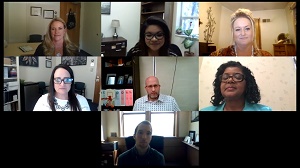2.1.3: Working in Groups Online
- Last updated
- Save as PDF
- Page ID
- 113638
Learning Objectives
After completing this addendum, students should be able to:
- describe how virtual copresence enhances group development.
- differentiate media poor and media rich modes of interaction.
- use a video conference platform to engage in an online task group.
- use a collaboration platform to produce work for an online task group.
- initiate and manage an online task group.
With the constant connectivity of the internet and easily available video conference tools, more and more task group work is being accomplished online. Instead of the time and cost required to bring a group together, members can join the group from work, from home, or from anywhere they have internet access.
Online task groups have the same basic dynamics as face-to-face groups with some slight variations. We will look at some tools and techniques to aid online task groups in functioning effectively.
Video Conferencing
Because of the concepts of copresence and media richness theory, we know the most effective communication occurs face-to-face, in the same room at the same time. With online groups, however, such a physical presence is not possible. Instead, as best we can, we work to replicate the face-to-face environment.

Copresence is the degree to which we are aware of the other person, and how “present” they are, psychologically and physically, in the encounter (Atlschuller & Benbunan-Fich, 2010). Consider how present we are in a face-to-face encounter compared to something like texting or even a phone call. The more we are aware of and feel involved with the other person, the better we communicate. In online communication, we aim for virtual copresence, using various technologies to mimic the face-to-face encounter as much as possible. While we can never achieve pure copresence, we can aim to get as close as possible.
Media Richness Theory tells us that different forms of communication have more message data and, therefore, result in a fuller, more detailed communication event. (Schiefelbein, 2012) Face-to-face communication is the richest form of communication there is. Think of how much we learn about a person when we can hear and see them as compared to how little personal information we get from an email or a text. With online task groups, meeting face-to-face is not practical, but we want to replicate that data-rich face-to-face experience as best we can. Relationships build more effectively because we get far more information in this richer mode to allow us to lower uncertainty, build predictability, and develop trust more quickly.
Video Conference Tools
While there is a myriad of high-powered video conference tools exist for video conferencing, we will focus on the free ones readily available to students. The challenges, however, apply to any platform a group may use.

By far the most common video conference service is Skype. Skype allows for free group calls up with up to twelve members, and it allows the user to see all other members at the same time. There are similar tools such as Google Hangouts, and with the ever-expanding internet, other options come and go at a regular pace. Regardless of which tools a group uses, some things to keep in mind:
- Bandwidth. Video requires a lot of data, so members on a slower internet connection may have more trouble seeing and hearing everyone. One option is for those individuals to find a location, such as a coffeeshop, public library, or college, where the internet speeds may be faster.
- Cross-platform capabilities. For most internet-based tools, whether the user is operating a Mac or PC typically makes little difference. More issues may arise if someone is trying to participate via a phone or tablet. Generally, members will get the best video conference experience from a laptop or desktop.
- Sound. While most newer built-in microphones and speakers will probably suffice for most meetings, to ensure good quality use a headset with headphones and a microphone. This will generally lead to the best audio.
- Technology Challenges. Whenever relying on technology to communicate, the safest assumption to work with is that something will go wrong. Logging in several minutes before the planned start time to give an opportunity to work issues out avoids losing quality work time. Also, since each of us has a different comfort level with technology, be prepared to help each other navigate the software.
Other Communication Tools
In addition to video conferencing, other communication tools are certainly appropriate to use in order to stay connected. Which tool works best for your group is up to the group; perhaps a discussion board is best, or texting, or Facebook messaging. As long as the group agrees on the tools to use, and uses them as expected, whatever works for the group is fine.
Online Collaboration Tools
Since all groups, whether online or face-to-face, must eventually produce something, the group needs a method to do so that will allow for collaboration but also ease completing the product. Two tools that excel at this are Google Docs and Office 365. Either of these tools allows all members of a group to collaboratively edit documents, slideware presentations, spreadsheets, or a number of other items. With revision tracking and commenting features, both are robust tools for group collaboration. One benefit of Google Docs is it is free and not dependent on having access to Office 365.

The ideal scenario is for members to have their video conference window open, along with the collaboration tool. Group members may then see and hear each other, discuss the task, while creating and editing the work the group needs to produce. This arrangement for allows for virtual copresence in a media rich environment, which in turn sets the stage for healthy interaction.
To Be Successful in Online Groups
Successful task groups must be managed thoughtfully and purposefully. There are distinct things groups can do to be more successful. These are choices, they do not just happen. The members must decide to make the group work.
- Be proactive. Do not wait for others to step up and suggest things or get things going. Especially for online groups it is very easy to sit back and wait for others to take the lead; that does not work online.
- Deliberately engage others. Invite participation, ask questions, and listen attentively. While no one can make a reluctant member participate, be sure you have extended the invitation several times. It takes different people different amounts of time to develop a comfort level with the group, so at least at the beginning be sensitive to that. Eventually, the group needs to transition to an expectation that each member will be engaged, but a gentle beginning can ease everyone in.
- Be flexible in how you work. Remember the adage, “everyone adapts to everyone.” The group has to find its own comfortable style of working, and it may be different than what we would do working alone.
- Follow through on tasks. Respect each other’s schedules and outside demands, and follow through on assigned tasks. Otherwise, the group stalls while attempting to make up for a member to do their part of the work.
- Respect the group norms and ground rules. Remember we work best in an environment of low uncertainty. By being consistent in behavior and following the ground rules, members help add to a level of trust and comfort which allows the group to function more smoothly.
- Be realistic. Group work takes time, so all members need to be patient and allow for the group process to work.
- Do not let social loafers control the group. A social loafer is a person who fails to participate in the group, typically by attending sporadically yet not engaging in the group process. This is the person who wants to get credit for the work without really doing anything. They have placed the group as a very low priority, yet they realize they must stay connected, even if to a minor degree, to satisfy the teacher or boss. The danger with social loafers is our tendency to be nice to them, to hold off on decisions until everyone is present, or to take time to revisit decisions once absent members reappear. If group members choose not to attend the group work must still continue to move forward.
For any task groups to function effectively, each member must be engaged and take responsibility for making the group work. For online groups, those needs are even greater due to the challenges of not being in a face-to-face setting. However, through the use of video conferencing and other collaborative tools, a group can create an effective work environment.
Key Concepts |
The terms and concepts students should be familiar with from this section include:
Video Conferencing
Media Richness Theory
Virtual Copresence
Using Video Conferencing
Other Collaboration Tools
Being Successful with Online Groups
References
Altschuller, S., & Benbunan-Fich, R. (2010). Trust, performance, and the communication process in ad hoc decision-making virtual teams. Journal of Computer-Mediated Communication, 16, 27-47. International Communication Association.
Bormann, E.G., & Bormann, N.C. (1980). Effective small group communication (3rd ed.) Minneapolis, MN: Burgess Publishing Company.
Fisk, A.P. (2013), The inherent sociability of homo sapiens. Human Sociality. Retrieved 4/1/13 from http://www.sscnet.ucla.edu/anthro/fa...e/relmodov.htm
Fournier, G. (2010). Social exchange theory. Retrieved 3/22/13 from psychcentral.com/encyclopedia...change-theory/
Schiefelbein, J. (2012). "Media Richness and Communication in Online Education." Facultyfocus.com Retrieved 4/1/13 from http://www.facultyfocus.com/articles...edia-richness- and-communication-in-online-education/


